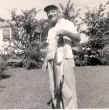In May of 1980, I decided to make an afternoon trip to one of the creeks feeding into Lake Conroe for a go at some bass. Having been given some brief instructions about getting to the spot, along with the possibility of catching some fish, I left work early and headed out. Going the “back way” from my home in Cypress, Texas this was a less than one hour, trip. Heading up FM 149, now freeway and four lanes all the way to Texas 105, and going through Montgomery, I continued north on 149 for two or three miles, crossed the first bridge and exited the road.
There was no launch ramp, just two ruts leading toward the water. Huffing and puffing my twelve-foot, aluminum boat, electric motor, battery, paddle, rod and tackle box, I, with wet feet, unceremoniously launched it. This is the same one that, in Georgia, I caught the twelve pound, bass out of a year earlier. Push polling with the paddle, finally paddling, I got the boat into deeper water, cranked up the electric motor, headed under the bridge and started casting. My bait of choice was a dark green, Lucky 13, a proven top water plug.
Outside of the creek channel, there was a big hydrilla, a very intrusive moss, laden flat, a likely looking spot, with a few lily pads thrown in and I headed toward it. Pick a spot in the moss, cast out, let the 13 sit until the rings disappeared, then twitch it and repeat if necessary. My second cast, after the rings settled, abruptly, a nice bass came out of the water and, on the way back into the water, clamped down on the Lucky 13. Having caught a lot of bass in the past, I’d never seen this before, a reverse blow-up! After several jumps, I reached down and lipped it, a nice, four pounder. Throwing it back, I kept on casting and twitching.
Casting into another opening, letting the rings settle, twitching the plug twice, another bass, a twin of the first, exploded into the 13 and the fight was on. Landing it and throwing it back, I continued casting for the next hour, with no luck. Heading back towards the “launch ramp”, I figured that with the lake up this would remain a good spot through June or until the water level dropped.
Getting home, I told Randy about the spot and gave him better instructions about finding it. He went up there the next weekend with a friend and was using a jig around the bridge pilings and caught a spinning rod and reel. It was a nice expensive, outfit that we cleaned up and used it in salt water for the next twenty years!
Now, for the rest of the story, Lake Conroe was once considered one of the top five bass fishing spots in the nation. We did fish this spot for the next year with some success, but then, to control the hydrilla, the State of Texas introduced grass carp, white amur, supposedly these fish were sterile, but they weren’t! Within a year and a half the carp had eaten up our fishing spot. By 1996 the carp, without any vegetation to eat, died out, vegetation rebloomed and the bass fishing improved with it. Now the State, the lake front property owners, various interested national organizations, fishing clubs and the San Jacinto River Authority are working together to control the hydrilla and other harmful plants and the fishing should improve.



